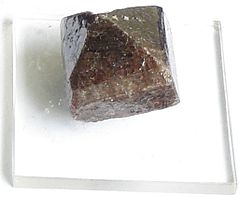Zircon
| Zircon | |
|---|---|

Zircon crystal from , Brazil (2×2 cm)
|
|
| General | |
| Category | Nesosilicates |
|
Formula (repeating unit) |
zirconium silicate (ZrSiO4) |
| Strunz classification | 9.AD.30 |
| Crystal system | Tetragonal |
| Crystal class | Ditetragonal dipyramidal (4/mmm) H-M symbol: (4/m 2/m 2/m) |
| Space group | I41/amd |
| Unit cell | a = 6.607(1), c = 5.982(1) [Å]; Z = 4 |
| Identification | |
| Color | Reddish brown, yellow, green, blue, gray, colorless; in thin section, colorless to pale brown |
| Crystal habit | tabular to prismatic crystals, irregular grains, massive |
| Twinning | On {101} |
| Cleavage | {110} and {111} |
| Fracture | Conchoidal to uneven |
| Tenacity | Brittle |
| Mohs scale hardness | 7.5 |
| Luster | Vitreous to adamantine; greasy when metamict. |
| Streak | White |
| Diaphaneity | Transparent to opaque |
| Specific gravity | 4.6–4.7 |
| Optical properties | Uniaxial (+) |
| Refractive index | nω = 1.925–1.961 nε = 1.980–2.015, 1.75 when metamict |
| Birefringence | δ = 0.047–0.055 |
| Pleochroism | Weak |
| Fusibility | close to 2,550 °C depend on Hf,Th,U,H,etc... concentrations. |
| Solubility | Insoluble |
| Other characteristics | Fluorescent and radioactive, may form pleochroic halos |
| References | |
Zircon (pronunciation: /ˈzɜːrkɒn/ or /ˈzɜːrkən/;) is a mineral belonging to the group of nesosilicates. Its chemical name is zirconium silicate and its corresponding chemical formula is ZrSiO4. A common empirical formula showing some of the range of substitution in zircon is (Zr1–y, REEy)(SiO4)1–x(OH)4x–y. Zircon forms in silicate melts with large proportions of high field strength incompatible elements. For example, hafnium is almost always present in quantities ranging from 1 to 4%. The crystal structure of zircon is tetragonal crystal system. The natural color of zircon varies between colorless, yellow-golden, red, brown, blue, and green. Colorless specimens that show gem quality are a popular substitute for diamond and are also known as "Matura diamond".
The name derives from the Persian zargun meaning gold-hued. This word is corrupted into "jargoon", a term applied to light-colored zircons. The English word "zircon" is derived from "Zirkon," which is the German adaptation of this word. Yellow, orange and red zircon is also known as "hyacinth", from the flower hyacinthus, whose name is of Ancient Greek origin.
...
Wikipedia
